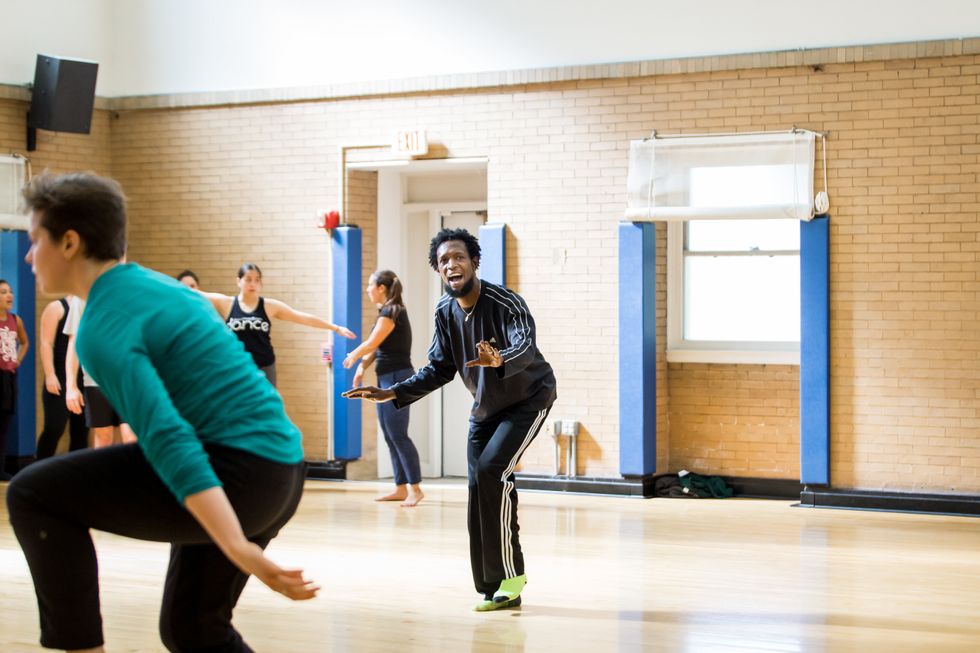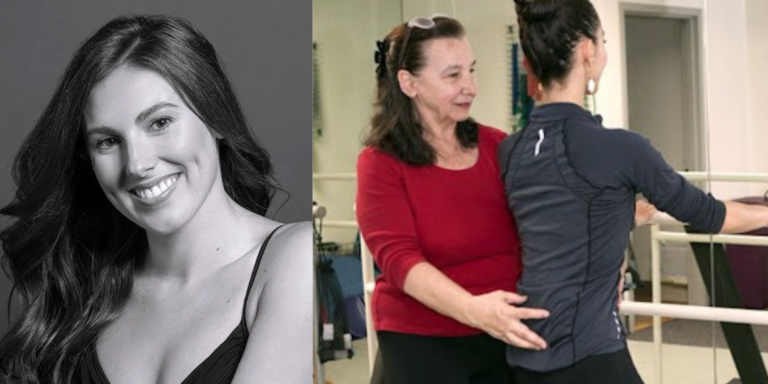
When COVID-19 forced college classes onto Zoom in March, dance professors scrambled to figure out how to represent physical movement in digital space.
Later in the summer, equipped with cleaning supplies and masks, some institutions announced plans for in-person instruction for the fall semester.
But as the pandemic found its way into dorms and classrooms, many schools quickly shifted back to Zoom University’s virtual hallways. Across the country, dance departments spent the first half of the semester leaping back and forth between in-person and online existences. Here, six professors share their experiences.
Chris Walker, University of Wisconsin–Madison, Professor of Dance

Sarah Maughan, courtesy Walker
UW-Madison faced spikes of COVID-19 early in the fall semester and paused all in-person instruction for two weeks in September. There are some hybrid classes now, but Walker has taught online courses for several years and continues to teach fully remotely this fall.
“I teach two courses online, one is synchronous and one is asynchronous. With the asynchronous course, I noticed early in the semester that I had to push for deeper investigation because students spend so much time online and this just becomes one more thing to do. So, I try to think of all the questions they might have beforehand and present a sort of FAQ page to substitute the explanations I could usually give in person.
“That said, I also see the new format as a positive. In face-to-face classes, I would show videos and then we would move on quickly, but now that students have the opportunity to watch on their own time, I notice that they also end up clicking on the related videos that pop up next to the links that I send them. Then they bring up that new content in their online discussions and it’s really expanding their understanding of the sources. So when we go back to in-person classes, that will be one asynchronous aspect that I’ll want to keep the same—giving students opportunities for independent research spaces.”
Matt Pardo, James Madison University, Assistant Professor of Dance

JMU started in-person classes this fall but shifted to online learning after cases of COVID-19 spiked just five days later. The university gave special exception to the dance department and allowed instructors to teach hybrid classes (some students in-person and some on Zoom). Pardo now teaches most of his classes using multiple studios at once, sometimes in different buildings, all connected through Zoom.
“We were prepared to shift online if we needed to, I just didn’t think it would happen so soon. Now, one group is with me in the studio, one group is in another studio across campus and a third group is at home by themselves. But even in those other spaces, you can still see them giggle when I call out their name. So, personal corrections are ways to advance students forward in their training but are also personal check-ins to let them know that they’re not alone and that we can see them. They’re almost community-building. I try to at least say everyone’s name—it might not happen in every class, but it really helps to engage them critically.”
Rebecca Herrin, University of Oklahoma, Ballet Instructor
OU allowed classes with under 40 students to continue in person until Thanksgiving break, but Herrin also had to employ hybrid formats when students exposed to COVID-19 were asked to quarantine.
“We had COVID in our program, so there have been situations where students had to Zoom in. That’s really hard. You’re trying to acknowledge the people that are in the space but then also think the class through to make modifications so the content is still relevant to those that are in quarantine.
“I added an online-discussion component for the studio classes, so I give some guiding reflections that they can discuss, talking about the victories they had for the week, or the challenges. Then they reply to one other colleague in the class, so it’s providing a sense of community. One of the other things I’ve done is give video quizzes; we’ll do a combination in class and then they submit a video online. I wanted to make sure that they were well versed in the technology so that if we did come to an online situation that I could use that.”
Melinda Jean Myers, University of Iowa, Assistant Professor of Contemporary Dance and Choreography
UIowa’s dance department planned to return with in-person instruction, but a week before the start of classes the dance building failed its ventilation test. Now, most classes take place online, with a few hybrid opportunities in other spaces across campus.
“It’s a bit awkward for us as a department because this semester there’s no ‘home base’—we’re mostly coming together online and we offset some classes into a bunch of other spaces across campus. We’ve also been dancing outside a lot, but each time that alters the variables and shifts what’s possible: wet grass, bees and bugs, sun, wind, rain. Nothing is a simple solve, but we also have Hancher Auditorium, which is a really big presenting venue in the Midwest. They’re dark this season and they’re allowing us to dance on their stage and also in one of their rehearsal studios. It’s an awesome opportunity for the students to take class on a big opera stage.
“I think the hardest thing that I’m lacking clear answers for myself is ‘How do I create a really vibrant community space in this environment where some of us are physically absent and some of us are physically present?’ One of the tactics I’ve brainstormed is to start class with a check-in process. I usually hold the computer so the in-person students can see those online and everyone has an opportunity to show up with either a physical offering or an ‘I’ statement. It allows for everyone to hear and feel this starting point of where people are coming from.”
Amy West, University of Michigan, Lecturer of Dance

Eden West, courtesy West
U-M started classes in hybrid formats this fall, but after about a month the dance building closed for two weeks when exposure rates within the department spiked. Students are now allowed back into limited-capacity studios, but West chooses to continue teaching from home.
“Given what we all faced in March, we knew there was a strong possibility that things would need to be shut down, so we were all prepared with a remote teaching plan before the semester started. Hybrid posed challenges because of trying to be in two places at once. Realistically, if I had my back to my computer screen, my back would be to the students that were in person. Who do I watch? Do I watch the in-studio people or do I watch the Zoom people? I felt my attention to be very divided.
“I’m focusing on what we can do, in the utilization of the space and floor. Carpet, for example, generally has a pad underneath and that can help to make the ankles work harder since the floor has more give—one has to work their feet a bit harder to brush, making their feet stronger. A more slippery floor, like wood or linoleum, can really make a dancer use their rotator muscles to maintain rotation rather than rely on a less slippery floor to hold the rotation.”
Duane Holland, University of Wisconsin–Madison, Assistant Professor
Holland teaches hip hop and contemporary at UW-Madison. He moved his classes online at the start of the COVID-19 pandemic, and though given the option to teach in person this fall, he felt the new remote format better served his courses’ content.
“At the beginning of the fall semester I was supposed to teach face-to-face, but I requested a virtual space instead. Based on the success I experienced going virtual during the second half of the spring semester, I found the online space allowed me to provide a stronger foundation.
“Online, I’ve been able to create a space for bringing up the magic of the culture that had previously not been given access to these academic spaces. We’ve had time to dig into what the community is, what the culture is, and how that community doesn’t necessarily reflect the cultural accommodation of how Black vernacular or Black American culture is packaged in face-to-face spaces. Now, the students are realizing that they missed out on the actual essence of the culture, which they’re finding out informs how they execute the movement.”




